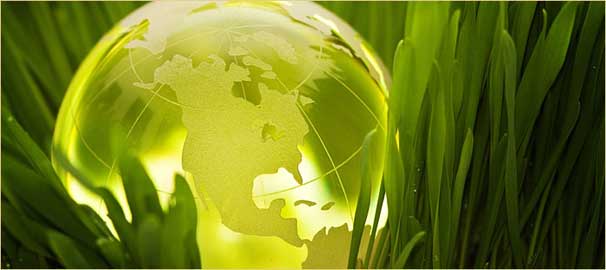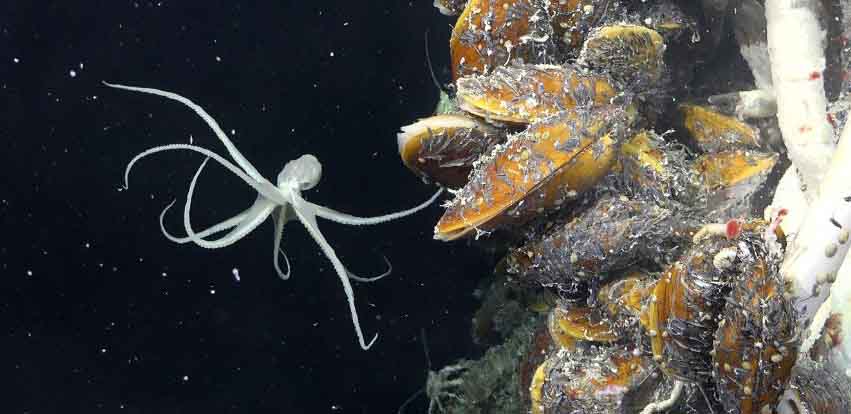


Scientists Find A Whole New Ecosystem Hiding Beneath Earth's Seafloor Science Alert - August 9, 2023
Scientists keep peeling back new layers of life on our planet like a seemingly endless onion. Most recently, aquanauts on board a vessel from the Schmidt Ocean Institute used an underwater robot to turn over slabs of volcanic crust in the deep, dark Pacific. Underneath the seafloor of this well-studied site, the international team of researchers found veins of subsurface fluids swimming with life that has never been seen before. It's a whole new world we didn't know existed.
Ecology is the scientific study of interactions among organisms and their environment, such as the interactions organisms have with each other and with their abiotic environment. Topics of interest to ecologists include the diversity, distribution, amount (biomass), number (population) of organisms, as well as competition between them within and among ecosystems. Ecosystems are composed of dynamically interacting parts including organisms, the communities they make up, and the non-living components of their environment. Ecosystem processes, such as primary production, pedogenesis, nutrient cycling, and various niche construction activities, regulate the flux of energy and matter through an environment. These processes are sustained by organisms with specific life history traits, and the variety of organisms is called biodiversity. Biodiversity, which refers to the varieties of species, genes, and ecosystems, enhances certain ecosystem services.
Ecology is an interdisciplinary field that includes biology and Earth science. The word "ecology' was coined in 1866 by the German scientist Ernst Haeckel (1834-1919). Ancient Greek philosophers such as Hippocrates and Aristotle laid the foundations of ecology in their studies on natural history. Modern ecology transformed into a more rigorous science in the late 19th century. Evolutionary concepts on adaptation and natural selection became cornerstones of modern ecological theory. Ecology is not synonymous with environment, environmentalism, natural history, or environmental science. It is closely related to evolutionary biology, genetics, and ethology. An understanding of how biodiversity affects ecological function is an important focus area in ecological studies. Ecologists seek to explain:
The movement of materials and energy through living communities
The successional development of ecosystems, and
The abundance and distribution of organisms and biodiversity in the context of the environment.
The scope of ecology covers a wide array of interacting levels of organization spanning micro-level (e.g., cells) to planetary scale (e.g., biosphere) phenomena. Ecosystems, for example, contain abiotic resources and interacting life forms (i.e., individual organisms that aggregate into populations which aggregate into distinct ecological communities).
Ecosystems are dynamic, they do not always follow a linear successional path, but they are always changing, sometimes rapidly and sometimes so slowly that it can take thousands of years for ecological processes to bring about certain successional stages of a forest. An ecosystem's area can vary greatly, from tiny to vast. A single tree is of little consequence to the classification of a forest ecosystem, but critically relevant to organisms living in and on it.
Several generations of an aphid population can exist over the lifespan of a single leaf. Each of those aphids, in turn, support diverse bacterial communities. The nature of connections in ecological communities cannot be explained by knowing the details of each species in isolation, because the emergent pattern is neither revealed nor predicted until the ecosystem is studied as an integrated whole. Some ecological principles, however, do exhibit collective properties where the sum of the components explain the properties of the whole, such as birth rates of a population being equal to the sum of individual births over a designated time frame.

Biodiversity is the degree of variation of life. This can refer to genetic variation, species variation, or ecosystem variation within an area, biome, or planet. Terrestrial biodiversity tends to be highest at low latitudes near the equator, which seems to be the result of the warm climate and high primary productivity. Marine biodiversity tends to be highest along coasts in the Western Pacific, where sea surface temperature is highest and in mid-latitudinal band in all oceans. Biodiversity generally tends to cluster in hotspots, and has been increasing through time but will be likely to slow in the future.
Rapid environmental changes typically cause mass extinctions. One estimate is that <1%-3% of the species that have existed on Earth are extant.
Since life began on Earth, five major mass extinctions and several minor events have led to large and sudden drops in biodiversity. The Phanerozoic eon (the last 540 million years) marked a rapid growth in biodiversity via the Cambrian explosion—a period during which the majority of multicellular phyla first appeared.
The next 400 million years included repeated, massive biodiversity losses classified as mass extinction events. In the Carboniferous, rainforest collapse led to a great loss of plant and animal life. The Permian–Triassic extinction event, 251 million years ago, was the worst; vertebrate recovery took 30 million years. The most recent, the Cretaceous–Paleogene extinction event, occurred 65 million years ago and has often attracted more attention than others because it resulted in the extinction of the dinosaurs.
The period since the emergence of humans has displayed an ongoing biodiversity reduction and an accompanying loss of genetic diversity. Named the Holocene extinction, the reduction is caused primarily by human impacts, particularly habitat destruction. Conversely, biodiversity impacts human health in a number of ways, both positively and negatively.
The United Nations designated 2011-2020 as the United Nations Decade on Biodiversity. "Biodiversity" is most commonly used to replace the more clearly defined and long established terms, species diversity and species richness. Biologists most often define biodiversity as the "totality of genes, species, and ecosystems of a region". An advantage of this definition is that it seems to describe most circumstances and presents a unified view of the traditional three levels at which biological variety has been identified:
ecosystem diversity
genetic diversity